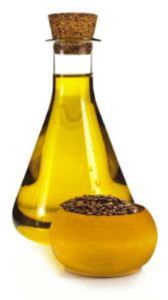It Has a Lot of Fatty Acids
Omega-3 fatty acids are great for your skin. People with dry, itchy skin or red, blotchy skin commonly find they’re deficient in omega-3 fatty acids, so they try to up their intake.
The best source of omega-3 fatty acids is fish. A lot of nutrition stores sell fish oil supplements for just this reason. But if you can’t or don’t want to consume fish or fish oil for whatever reason, flaxseed works great as an alternative.
Flaxseed contains a higher concentration of omega-3 fatty acids than any other plant, which keeps your skin hydrated and moisturized and helps create a protective barrier against environmental pollutants. All of which help to decrease the appearance of wrinkles.
It’s also rich in alpha-linoleic acid, an essential fatty acid you can only acquire through food, and lignans, a group of chemical compounds that flush excess estrogen from your body and relieve you of menstrual symptoms. Lignans have even been linked to reducing the risk of breast cancer due to their anti-inflammatory and antioxidant energy.
Researchers and physicians have known about the benefits of flaxseed for many years, even taking from the medical journal of Hippocrates who widely used flaxseed during the height of the Roman Empire for its quick wound healing benefits. In 2009, Silke De Spirt and a team of researchers published a study in the British Journal of Nutrition noting the link between using flaxseed oil and borage oil on the skin with a reduction of skin redness and an increase in sky hydration after 12 weeks of use. There was also a decrease in trans-epidermal water loss helping to decrease scaling of the skin.
How to Get It in Your Diet
You can add flaxseed to your diet in any of three ways: as flour, as oil, or ground up as meal.
Flaxseed flour works great in place of baking flour for many recipes, scoops of flaxseed meal can be added to breakfast smoothies, and flaxseed oil goes great over rice, salad, or steamed vegetables. You’ll get a nutty flavor from the meal and oil while benefiting your skin and digestive system. Two tablespoons of flaxseed meal also contains three grams of protein and four grams of fiber along with the fatty acids.
Be careful of that high fatty acid content, however, when using the oil. Keep flaxseed oil cool in the fridge, and never add it to heated pans. Even low heat can burn the flaxseed due to its high concentration of fatty acids. It can also go rancid quickly, so stick to smaller bottles. A simple salad dressing bottle in the fridge with an easy pour spout will make adding flaxseed to your diet a breeze.
Silke De Spirt et al., “Intervention with Flaxseed and Borage Oil Supplements Modulates Skin Condition in Women,” British Journal of Nutrition 101, no. 3 (2009): 440-5.




